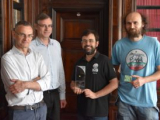Silicon vacancy (SiV) centers are optically active defects in diamond. The SiV centers, in contrast to nitrogen vacancy (NV) centers, possess narrow and efficient luminescence spectrum (centered at ≈738 nm) even at room temperature, which can be utilized for quantum photonics and sensing applications. However, most of light generated in diamond is trapped in the material due to the phenomenon of total internal reflection. In order to overcome this issue, we have prepared...
You are here
Significant results of scientific activity in year 2017
Porous and self-standing structures are highly promising as membranes, electrodes, high sensitivity gas sensors, and supercapacitors due to their high surface area and tuneable surface properties. Composition of such materials with a polycrystalline diamond film may provide new functionalities for biological and electrochemical applications. However, the diamond growth on foreign substrates as a pinhole-free continuous thin film is still a not a trivial task. Here, we...
Single crystals of Cs2HfCl6 have recently been identified as promising scintillating material. Furthermore, extended first-principles calculations of Cs2HfCl6 electronic and optical properties have been reported, which, among others, indicate the self-trapping of holes and electrons in the form of VK and polaron centers, respectively. Renewed interest in halide scintillators appeared in the late 1990s when rare-earth-based...
Using liquid phase epitaxy, the Mg co‐doped multicomponent garnet film scintillators of composition((Ce0.01Lu0.27Gd0.74)3– xMgx(Ga2.48Al2.46)O12, x = 0–0.002 (0–700 at. ppm) are prepared. Following luminescence and scintillation characteristics and their dependence on Mg concentration are studied: photoluminescence emission and excitation spectra, radioluminescence spectra, photoluminescence and scintillation decay...
In this work, we demonstrate and describe an effective method of protecting zirconium fuel cladding against oxygen and hydrogen uptake at both accident and working temperatures in water-cooled nuclear reactor environments. Zr alloy samples were coated with nanocrystalline diamond (NCD) layers of different thicknesses, grown in a microwave plasma chemical vapor deposition apparatus. In addition to showing that such an NCD layer prevents the Zr alloy from directly...
The fast nanotechnology advancements in recent years resulted in the development of numerous nanomaterials, which often possess complex structures and surface functionalization1,2,3. Biomedical applications (for example, imaging, diagnosis, drug delivery, etc.) of functionalized nanoparticles (NPs) are steadily increasing1,2,3,4. Due to small particle size and their large surface area, NPs possess chemical and physical properties that cannot be achieved by the...
Unknown quantum information cannot be perfectly copied (cloned). This statement is the bedrock of quantum technologies and quantum cryptography, including the seminal scheme of Wiesner’s quantum money, which was the first quantum-cryptographic proposal. Surprisingly, to our knowledge, quantum money has not been tested experimentally yet. Here, we experimentally revisit the Wiesner idea, assuming a banknote to be an image encoded in the polarization states of single...
Nanostructured surfaces are of high interest for various scientific, biomedical and industrial applications. Numerous methods exist to produce nanostructured surfaces based on sputtering, chemical and plasma etching, chemical vapor deposition, self-assembly, nanoimprint, optical and physical lithography. Lithography techniques such as electron- and focused-ion- beam lithographies, and photolithography are most commonly used and provide high-precision nanostructuring....
The generation of uniformly dense and uniformly heated high-density plasmas created sufficiently rapidly so as to prevent significant hydrodynamic motion during their diagnosis has long been a goal in the field of laser-matter interactions, as such plasmas would provide an environment to make benchmark tests of several fundamental optical, thermodynamic, and transport properties of strongly coupled matter which are important for furthering our understanding of systems...
The intensities of the order of 1023–24 W/cm2 are required to efficiently generate electron-positron pairs in laser-matter interaction when multiple laser beam collision is employed. To achieve such intense laser fields with the upcoming generation of 10 PW laser beams, focusing to sub-micron spot size is required. In this paper, the possibility of pair production cascade development is studied for the case of a standing wave created by two tightly focused colliding...











